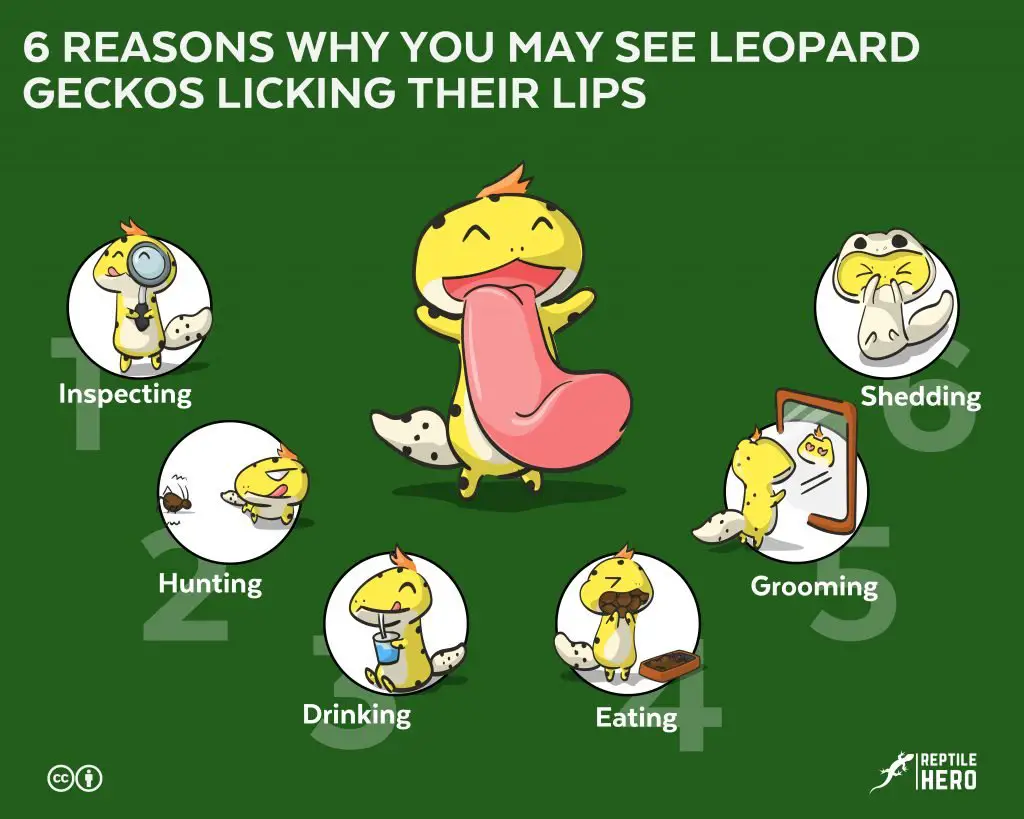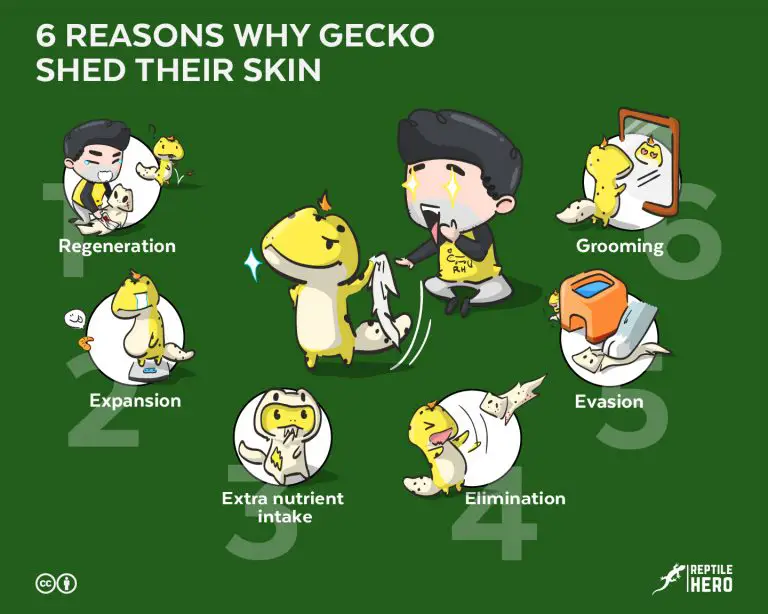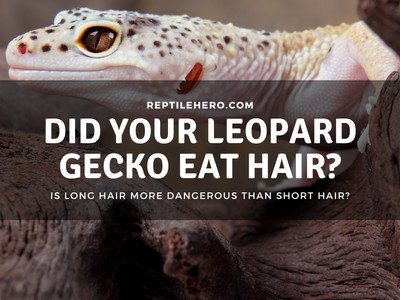Why Do Leopard Geckos Lick Their Lips? Should You Be Worried?
Lip-licking leopard geckos: it’s not exactly a popular topic within the reptile-keeping community. But it’s definitely something worth discussing―especially since it could be a sign that your gecko is at great risk of getting extremely sick!
As a general rule, labial or lip-licking is normal behavior for leopard geckos in the context of the following activities:
- Inspecting
- Hunting
- Drinking
- Eating
- Grooming
- Shedding
However, excessive labial-licking coupled with abnormal symptoms may serve as an early sign of injury or illness according to keepers.
Basically, repetitive lip-licking can be both a harmless natural behavior and a sign of an incredibly serious condition. So how can you distinguish which of the two is true for your precious pet leopard gecko? Continue ‘til the end to find out!
6 Reasons Why You May See Leopard Geckos Licking Their Lips
Now that we are aware of the fact that lip-licking, also referred to as labial-licking, is a distinctly different lingual movement from simple flicking of the tongue, let’s find out the common―and normal―reasons why your gecko keeps licking its lips!

#1 – Inspecting
Leopard geckos typically engage in labial-licking after an initial tongue-flick, when chemosensory sampling first occurs. Scientists believe that such lip-licking behavior is performed for better transfer, redistribution, and analysis of chemical samples obtained from their environment.
In other words, leopard geckos lick their lips repeatedly after sampling to make better sense of the world around them. So the next time you observe your soft-scaled little buddy licking its lips even though there is nothing touching or stuck in its labial scales, don’t fret!
More likely than not, your cute leo is simply doing some investigating. Among other things, you may see them do this in a novel space, around a recently changed or added tank decor, or near more familiar objects and people.
Interestingly, female leopard geckos in particular also display lip-licking once they pick up on male pheromones [1]. Hence, we can consider lip-licking in our little lady leos as a definite sign of potential mate identification.
If you’re housing a pair of male and female geckos together in one vivarium but not planning on having them go through with breeding and laying eggs. As always, I really do recommend the separate housing of leos as soon as possible and never place them together if you are not an expert breeder.
#2 – Hunting
Ordinarily, leopard geckos engage in both tongue-flicking and lip-licking while hunting for prey recognition, location, and prehension. As considerably slow active foragers, both are essential for successful prey capture of leopard geckos.
From the research studies I have read throughout the years as a reptile pet parent, it seems that much is still uncertain regarding the differentiation between the significance of tongue-flicking and lip-licking in leopard geckos.
However, there are some theories put forth by scientists to better distinguish one from the other [2, 3].
Researchers who have covered studies on reptile tongues―including that of leopard geckos―believe that the distinction between the two tongue movements may be done by comparing their primary functions in relation to hunting.
Flicking:
Tongue-flicking during foraging is done mostly when searching for live feeders. The increase in its rate of incidence after a successful capture and consumption may point to the search for additional prey.
Licking:
In contrast, lip-licking is likely performed by leopard geckos for better processing of a potential prey’s chemical cues initially obtained via tongue-flicking. Plus, unlike tongue-flicking, lip-licking is usually done when a leo is immobile.
As such, subtle lip-licking may also allow leopard geckos to stay undetected by their prey and potential predators all the while maintaining vigilance and processing stimuli.
Leopard geckos seem to only markedly perform frequent labial-licking (20+ licks) within the first minute after cue presentation. After that full minute, the rate declines and remains low.
#3 – Drinking
Due to the inherent mouth structure of leopard geckos, and many other lizard species, they appear to repeatedly lick their lips whenever drinking water as they cannot take in liquids via sipping or suction [4].
When it’s a hot day out and you want to cool down and get hydrated, you would probably choose to chug a big glass of cold water. But our soft-scaled leos are not capable of doing that.
In comparison to most large animals, leopard geckos cannot take in large volumes of water. Instead, leopard geckos can only take in minimal amounts of water using the tips of their foretongue.
For a single drinking bout, they perform approximately 20 to 30 licks before they tilt their small heads upwards to aid in swallowing.
Depending on whether the water source is close to their mouth, this action may either resemble tongue-flicking when the source is relatively far and lip-licking when the source is nearby.
So it is totally normal to see your gecko seemingly licking its lips over and over again near or inside its water bowl, during sauna and soaking sessions, or after misting the tank―near the plants or any other decor that has water droplets on it.
#4 – Eating
The average leopard gecko uses its whole mouth to strike and catch prey, its tongue also plays a role in keeping the live insects within its oral cavity, preventing their escape. In doing so, leopard geckos may be observed licking their lips while eating and handling prey.
Lip-licking while eating is a completely expected behavior during mealtime if you really think about it―even for us humans. It helps make sure nothing goes to waste, like the tiniest crumbs of chocolate chip cookies your grandma baked especially for you.
The same is true for our little cold-blooded pets. Leos will make the most out of the insects you give them, even the stick-thin legs and antennas of a small cricket.
Well, that is unless you’ve got a picky eater in your hands. Remember to avoid overfeeding your geckos as well. Despite looking “chonky” and cute, fat geckos are not healthy geckos.
Lip-licking as a conditioned response in leopard geckos during feeding sessions.
Ever heard of Pavlov’s dog? It was a behavioral experiment where a dog was trained to salivate upon hearing the sound of a bell because it was previously presented together with food.
Some of my friends who primarily tong-feed their geckos have also noticed similar behavior in their pets during feeding sessions.
Due to the fact that they have gotten used to getting fed with the presence of a feeding tong―like this one on Amazon―leopard geckos will begin to lick their lips at the sight of the tong even though the food is not presented to them alongside it.
Other geckos have also been observed to react this way upon simply seeing their owners during a strictly scheduled meal time and so on.
#5 – Grooming
Generally speaking, lip-licking may also serve the function of self-grooming in leopard geckos after eating, drinking, or inadvertently getting substrate and any other material in and around their mouths.
Leos are most definitely not stupid animals. However, they do tend to take in not only prey but soil and sand when they pounce on their live meals.
If you ever do get to see your leopard gecko make this mistake, you would most definitely also witness it lick its lips constantly until it is finally able to get rid of all the dirt clinging onto its moist but scaly lips.
Of course, seeing your gecko persistently lip-licking after having a full meal or a good drink of clean and fresh water is no cause for alarm either. Much like us, leopard geckos also have a habit of making sure that they don’t have traces of food on and around their lips.
Presumably, this grooming function of lip-licking may also double as a defensive behavior in leopard geckos.
Think of it this way, if leopard geckos just left the smelly juices of insects on their bodies, hungry and dangerous predators would find them easy targets.
Aside from that, repeated grooming (i.e., lip-licking) after each live prey is consumed helps leopard geckos better detect other food options within the vicinity―kind of like cleansing their palate for the next dish.
#6 – Shedding
On average, leopard geckos may engage in more evident and persistent lip-licking during shedding. A process more precisely termed ecdysis.
Whether or not your husbandry is correct and up-to-date, you can expect to see your gecko licking its lips a lot more when it’s preparing to shed its dry old skin before gobbling it all up.
Reptiles like snakes and lizards naturally secrete some lymphatic fluid in the little space available between the new and dead skin to aid in the process of shedding [5]. But this dries up quickly when exposed to the air.
As such, the additional moisture from the saliva on a leopard gecko’s tongue further eases and hastens ecdysis.

By licking their lips during the shedding process, leopard geckos can better loosen and tear off the dead layer of skin covering their labials and the area around it with a reduced risk of injury.
It’s similar to how a wet strip of adhesive bandage is easier to pull off the skin compared to a dry strip. This is also why keepers and breeders are commonly advised by experts to treat dysecdysis―the abnormal shedding of skin―with the use of a damp cotton swab.
Now, you might be wondering: how often do leopard geckos shed their skin?
A juvenile leopard gecko can go through ecdysis as frequently as every 10 days (thrice a month), whereas an adult leopard gecko will only shed its old skin in intervals of approximately 40 to 60 days―once a month or every 2 months.
When is Frequent Lip-Licking a Sign of Health Problems?
Even though lip-licking is considered a natural behavior in leopard geckos, it may also be an indication of injury or the onset of a disease that could lead to premature death if not treated properly.
More often than not, symptomatic lip-licking for leopard geckos manifests in conjunction with other abnormal symptoms such as:
- Difficulty in holding down prey
- Inability to fully close the mouth
- Loss of weight
- Swelling and/or redness of oral tissue
If any of the above is displayed by your baby leo, I strongly advise you to immediately seek guidance and help from your veterinarian for proper examination, diagnosis, treatment, and prognosis.
Lip-Licking and Links to Life-Threatening Illness
According to experienced keepers and breeders, frequent lip-licking in leopard geckos unrelated to inspecting, hunting, drinking, eating, grooming, and shedding may instead be a symptom of the following:
- Oral injury and trauma
- Infectious/ulcerative stomatitis or mouth rot
- Nutritional secondary hyperparathyroidism or metabolic bone disease
Oral Injury
A leopard gecko with a cut or bruise on its mouth and/or lips is more likely to constantly lick its lips in an attempt to soothe the pain they experience.
To be completely honest, this is not something I was told by an exotic reptile veterinarian. The idea came to me only after hearing and reading stories from other keepers who have had wounded geckos constantly licking on their wounds.
However, I do think that it makes sense since we usually do this too―we lick our chapped lips so the stinging sensation is lessened, if not totally eliminated.
Mouth Rot
If not treated, such simple traumas around the oral cavity of leos may progress into the formation of an abscess on the mouth, and, subsequently, mouth rot.
Expert leopard gecko keepers and breeders have noted that incessant lip-licking becomes apparent before and during the development of infectious or ulcerative stomatitis―commonly referred to as mouth rot within the reptile community.
Though lacerations and bacterial infection can indeed lead to stomatitis, excessive stress and a compromised immune system due to poor husbandry are also major causes of mouth rot [6].
In severe―but not so rare―cases, this can spread into the esophagus, lungs, and even affect the bones of a leopard gecko and eventually lead to death.
Metabolic Bone Disease
I know that making the connection between lip-licking and metabolic bone disease (MBD)―or nutritional secondary hyperparathyroidism (NSHP)―isn’t exactly an easy task, since it isn’t part of the list of typical signs and symptoms for this specific condition.
However, numerous leopard gecko owners have noted that ones that already have weak jaws due to the calcium deficiency their diets tend to lick their lips to compensate for their lack of ability to grasp onto prey using their mouth.
Other indicators of nutritional secondary hyperparathyroidism include:
- Skeletal deformation(s)
- Abnormal flexibility
- Inability to move normally
- Lack of energy
Again, not giving a leopard gecko with MBD the appropriate and timely care, attention, and treatment it needs could leave you with no other choice but to opt for your leo’s euthanasia [5].
Leopard Gecko Tongue 101 (According to Science)
Now that we have discussed the exact reasons why your leos lick their lips―both good and bad―I think it is highly important that we also familiarize ourselves with the tongue of leopard geckos in general.
Do You Really Know How Your Leopard Gecko’s Tongue Look Like?
The tongue of leopard geckos may look extremely short and completely rounded out at the tip, but this is not the case.
Despite the lack of attention and observation this specific body part receives, on the whole, a few scientists have been able to view and inspect the tongue of the leopard gecko quite extensively [7].
Leopard geckos have elongated tongues which are triangular and considerably flat on both the top surface (dorsal) and underside (ventral). No taste buds were found on the dorsal side of the tongue, they are only located on the ventral side.
The 2 Main Sections of the Leopard Gecko Tongue
#1 ‒ Foretongue
The anterior portion of the leopard gecko’s foretongue is broad and wide. It also has a median sulcus which divides the tongue into equal halves.
The papillae here varies from front to back: flat and leaf-shaped (foliate) then dome-shaped. These become thicker toward the sides of the tongue surface, and also steadily taller before the hindtongue.
Predominantly red or dark pink, the tip of the foretongue―although seemingly curved―is forked (bifurcated).
In the posterior portion of the foretongue, the tongue is anchored to the floor of the mouth through the frenulum, a fold of mucus membrane found underneath the tongue.
#2 ‒ Hindtongue:
This is the portion of the leopard gecko tongue is found further into the oral cavity. It is much wider at the base and stretches out on either side of the larynx or glottis.
Both extending lobes are referred to as posterior limbs.
Here, only tall and overlapping foliate papillae were identified.
What are the Primary Functions of Leopard Gecko Tongues?
Similar to that of lizards’, the tongue of leopard geckos plays a significant role in investigative (e.g., chemoreception by taste and smell), social (e.g., vocal communication), and feeding activities (e.g., prey capture and ingestion), among many other things [2, 7].
Your leopard gecko’s tongue is not just for them to taste delicious worms―because it probably is for them. There is more than you can expect!
Moreover, many theorize that the distinct movements of the tongue may help differentiate among these.
The type, range, and span of time involved in each tongue movement may also help with drawing such functional distinctions.
Tongue-Flicking and Lip-Licking: What is the Difference?
Leopard geckos display two primary tongue movements or lingual protrusions [2, 3]:
#1 ‒ Tongue-flicking: the tongue stretches out, way beyond the lips, and gets in contact with the substrate or the air in front of the leopard gecko.
#2 ‒ Lip-licking: the tongue is swept or rubbed across the scales around the lips or labials of the leopard gecko―usually in the front and at the sides.
These two lingual protrusions cannot be done simultaneously. Instead, a leopard gecko may first engage in tongue-flicking then lip-licking, and/or vice versa.
Takeaways
On the whole, the natural and repeated lip-licking behavior of leopard geckos can have the following 6 biological functions: inspecting, hunting, drinking, eating, grooming, and shedding.
When peculiar labial-licking is displayed together with difficulty in eating, inability to close the mouth, weight loss, and inflammation of oral tissue, a leopard gecko may be injured and/or ill.
Frequent and peculiar non-functional lip-licking behavior in leopard geckos may be early signs of oral injury, mouth rot, and metabolic bone disease.
Sources
[1] http://www.ecolab.bas.bg/main/Members/snikolov/Cooper_Steele_1997_JCE_Eublepharis_macularius.pdf
[3] https://www.jstor.org/stable/1565700
[4] https://zslpublications.onlinelibrary.wiley.com/doi/abs/10.1111/jzo.12763
[6] https://myavho.com/storage/app/media/Infectious_Stomatitis_Care_Card.pdf


![Should You Directly Mist Your Leopard Or Crested Gecko? [4 Reasons and 4 Dangers]](https://www.reptilehero.com/wp-content/uploads/2021/07/Mist-Gecko-Infographic-768x614.jpg)

![Why Does Your Gecko Feel So Cold? [6 Potential Problems]](https://www.reptilehero.com/wp-content/uploads/2021/02/G43-768x614.jpg)

![Do Geckos Eat Their Own Poop? [The Science of Coprophagia]](https://www.reptilehero.com/wp-content/uploads/2021/08/Gecko-eat-poop-cc-1-768x614.jpg)